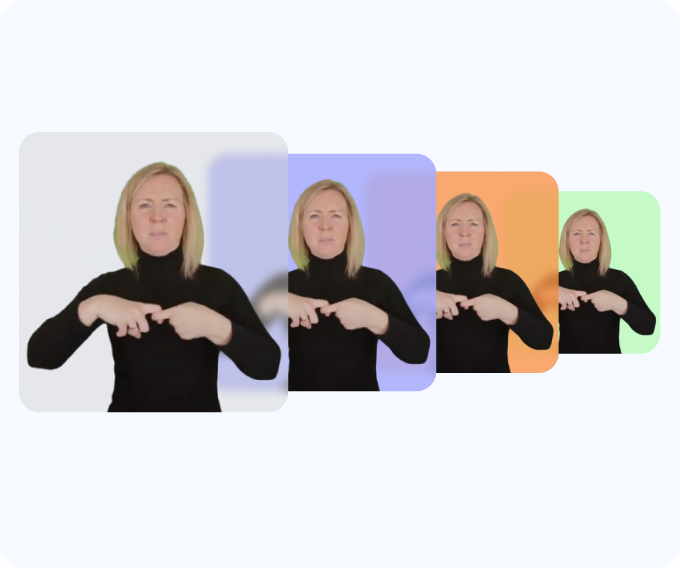Signapse's Sign Language Translation using Generative AI: Achieving Photo-Realism and Accuracy
Exploring the technical ability of Signapse's AI-driven sign language translation
Signapse is changing the way d/Deaf people access information in public spaces through its highly accurate and photo-realistic sign language translations. By using the power of Generative Adversarial Networks (GANs) and deep learning methodologies, Signapse provides an unmatched experience for d/Deaf users. In this article, we explore the technical details of Signapse's AI technology, discussing the importance of accuracy in sign language translation and how Signapse achieves it.
The Power of GANs in Signapse's Technology
Signapse uses Generative Adversarial Networks (GANs) to create photo-realistic sign language videos. This technology offers several advantages:
- Enhanced realism: GANs make the videos more appealing to d/Deaf users by generating videos that look like they were made by real people signing, rather than relying on Motion Capture-based graphical avatars, such as one in the picture below.
- Improved user experience: The realistic appearance of Signapse's videos promotes a more natural and engaging experience for d/Deaf individuals, helping them feel more connected to the content.

The Importance of Accuracy in Sign Language Translation
Accurate sign language translation is essential to ensure that d/Deaf individuals can fully understand the information being communicated. This includes:
- Making sure the meaning is accurate: Inaccurate translations can lead to misunderstandings, confusion and gaps in information, which can cause problems in public spaces like train stations.
- Respecting Deaf culture: Accurate translations must take into account the unique grammar, syntax, and details of sign language, showing a deep understanding of Deaf culture.
One of the key strengths of Signapse is its high accuracy, achieved through deep learning methodologies. This includes:
- Large dataset of sign language: Signapse utilises a vast collection of sign language videos made by qualified translators to ensure translations are as accurate as possible.
- Continuous updates: Signapse is constantly updated with new signs and translations as they are developed, ensuring its database remains current and clear.
Signapse's Translation Process
Signapse's translation process ensures smooth and accurate sign language translations for public announcements. In one of our previous articles, Automatic Transport Announcements, we explained the process of selecting the right videos and displaying the final translation on public screens.This process can be found below:
- Database of pre-recorded videos: Signapse keeps and maintains a database of all possible announcements and the pre-recorded sign language translation videos to match these.
- Video selection: Translators choose a combination of sign language videos based on the content of an announcement.
- AI-powered blending: Signapse uses AI solutions to blend the selected videos together perfectly, ensuring accurate syntax and grammar.
- Real-time updates: Integration with transport data means automatic updates for destinations, departure times, and platform numbers, generating live sign language announcements.
- Integration with digital displays: Signapse's software connects with digital displays, showing sign language videos on screens throughout train/bus stations or airports, providing equal access to information and services for the d/Deaf community.
The Future of AI-Powered Sign Language Translation

Signapse's AI-powered sign language translation technology offers extremely high levels of accuracy and photo-realism, providing d/Deaf individuals with a more engaging and accessible experience in public spaces. By using the power of Computer Vision and GANs, Signapse is transforming the way d/Deaf people access vital information and promoting greater inclusion within society.
As technology continues to advance, we can expect further improvements and innovations in AI-powered sign language translation:
- Enhanced personalisation: Future developments may enable users to customise the appearance of sign language videos to suit their preferences or needs, making them even more engaging and user-friendly.
- Wider application: Signapse's technology could be adapted for use in other contexts, such as educational materials, television broadcasts, or online content, further expanding accessibility for d/Deaf individuals.
- Advanced AI capabilities: As AI technology evolves, Signapse's deep learning methodologies and GANs could become even more advanced, delivering improved accuracy and realism in sign language translations.
By encouraging the potential of Generative AI in sign language translation, we can work towards a more inclusive and accessible world for the d/Deaf community.
If you’re interested in finding out more about the technical aspect of Signapse technology, we’d recommend reading our peer-reviewed publication, Signing at Scale: Learning to Co-Articulate Signs for Large-Scale Photo-Realistic Sign Language Production.
Related Articles
The Signapse AI Roadmap: Our Journey to Human-Level Sign Language Translation



